Lucie Machin was a conservation intern for Ascension Island’s Conservation Department from from November 2019 to November 2020. Here she describes the spectacle of the island’s green turtle nesting nights, during one of the busiest nesting years on record.
By the light of a full moon, the Atlantic Ocean crashed into the silver crescent of beach curving off into the distance. As I walked, my feet sank into the course-grained sand, still warm from the unforgiving sun, which had set a few hours beforehand. With my eyes gradually adjusting to the night, I could just make out black shapes slowly moving across the scene ahead of me, like shiny scarab beetles. Yet these were not scarab beetles but turtles, their carapaces (shells) glinting in the moonlight…and they were everywhere! I watched enraptured, as perhaps fifty or more proceeded to drag themselves laboriously up onto the beach, in readiness to lay their clutches of eggs in the sand.
These females were a tiny handful of the thousands of turtles which make their way to Ascension Island every year between November and June, to reproduce and nest. Although the island is only a tiny speck of land in the middle of a vast ocean, it is one of the most important sites for green turtles (Chelonia mydas) on the planet and the largest nesting population in the South Atlantic, with over 23,000 nests a year.
Ascension’s green turtles are enormous, with females weighing an average of 166kg and often measuring well over a metre in length, putting them among the largest of their species in the world. Although difficult to estimate, it is thought that they can live to around 80 years old. Their great size is likely an adaptation to their arduous journey to and from the island. They swim all the way from their feeding grounds in the waters off Brazil, over 2000 km away. Satellite tracking has shown that this journey alone takes around six weeks and is one of the greatest migrations of the animal kingdom. Nobody knows for certain how they find this tiny island year after year. Theories suggest that they are guided by scent, or perhaps they follow the earth’s magnetic field. Whatever the method, this homing instinct is thought to lead them to nest on the very same beach where they themselves started out.
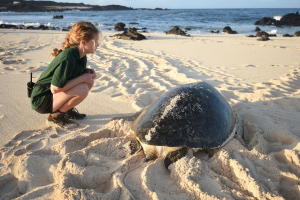
Green turtles are not, as their name suggests, necessarily green. Their carapaces come in a myriad of colours, from dark grey to exquisite, speckled olive green. Once I even saw one that was a vibrant turquoise. The name unfortunately comes from the colour of their flesh, which is still highly sought after in many parts of the world. Poaching continues to be one of the main threats to their survival worldwide. Indeed, Ascension’s own population was almost hunted to extinction between the 16th and early 20th centuries. By the 19th century, hunting had become a professional enterprise with over 1000 slaughtered a year for their meat, which was considered a delicacy at the time. By the time hunting was outlawed in the 1940s, the population had been completely devastated, with research suggesting that their numbers are still recovering from this wretched period.
Today, Ascension is one of the few places in the world where turtles are not threatened by egg harvesting or hunting. Conservation work to protect and monitor this population, supported by islanders, has taken place since 1977. It is calculated that nesting activity has increased over sixfold in this period (up from an average of 3700 nests a year). For some reason, some years see much higher levels of nesting activity than others. When I worked on the island, the 2019-2020 season was one such year. Our estimates suggested that it was among the most successful breeding seasons on record. The ongoing recovery in the turtle population on Ascension represents an incredible conservation success!
Funded by Blue Marine Foundation (BLUE), I had the amazing privilege of monitoring these turtles whilst working for Ascension Island’s Conservation Department. Prior to this, I had never even seen a turtle and so witnessing them was a constant source of fascination, delight and frequently bemusement. Our small team would often go to the beaches during the night to work alongside these turtles, either to collect data for long term research projects, or to lead tours for members of the public and the military.
Under the cover of darkness
On land, turtles have poor eyesight and hearing, so we would take great care to not startle them by moving carefully and avoiding the use of headtorches. An obvious advantage of this, apart from not startling the turtles, was that it allowed our eyesight to adjust to the spectacle unfolding around us. Slowly, we would become aware of the spectacular milky way arching above us, as the skies of Ascension swarmed with stars. With minimal light pollution, around the time of the new moon, we would navigate by the faint glow of starlight. In these times, we became aware of the stars reflected in the inky black ocean below. One time, the planet Venus, visible low in the sky, left a distinct light trail in the water like that of a small faint moon. Of course, this is not to say that navigation was easy, and we would all frequently fall over, tumbling unceremoniously into old turtle nesting holes!
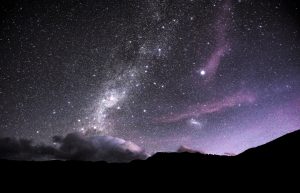
To avoid predation and overheating, turtles nest under the cover of darkness. First, a female turtle will ‘body pit’, where she digs a large depression in the sand with her powerful front flippers. This can take her several hours, or longer if she decides that the sand is not suitable. Some turtles will body pit several times during the night before settling on a suitable spot. Next, she will carefully excavate a smaller hole, about 15cm across and 20cm deep, at the bottom of this depression with her smaller back flippers. This will be the egg chamber, where her eggs will incubate. It can lie over a metre below the surface of the sand. We would scour the beach for turtles at this stage of the nesting process and then lie quietly nearby, waiting patiently for them to start laying eggs.
When looking to find nesting turtles, we would rely on sound and smell as well as sight, as turtles have a very distinctive odour. Think a mixture of reptilian-fishy-egg, and you would be on the right track. Unfortunately, when working with them every day, we would end up smelling a pungent combination of the same, plus that of sweat and sunscreen.
There were times when there were so many turtles on the beaches at night that we would have to carefully pick a path between them, all the while being hit in the face by flying sand. During the peak nesting season, around March, the beaches at night were nothing short of chaotic. Turtles were shoving each other out of the way, excavating each other’s eggs and chucking sand onto each other. On one occasion, we even found a turtle being buried alive by another. After some frantic digging, we managed to locate her head under about a foot of sand, eventually freeing her from what otherwise would have been certain death.
When turtles finish egg chambering, their brains release the hormone oxytocin, which puts them into a trance-like state and induces the laying process. It was only at this point that we would approach a turtle. Crawling up from behind, we would watch silently as she laid about 120 – 160 rubbery ping-pong sized eggs. We would carefully place a temperature logger, attached to a stake by a long piece of string, in the centre of these eggs, where it would record the nest temperature at regular intervals throughout the incubation period. If a hole was particularly deep, this could involve another member of our team holding on to my ankles as I lowered myself down headfirst into the nest, while carefully trying not to dislodge any sand into the nest. Easier said than done!
If you were wondering why anyone would want to measure nest temperature, it determines turtle gender, with incubation temperatures of 28.8⁰C resulting in a clutch of eggs being mostly female. A major concern with climate change is that warmer temperatures will result in fewer males. If the ratio of males to females is heavily impacted, this could limit their genetic diversity or even their ability to reproduce.
After her egg laying, we would then straddle the mother turtle with a measuring tape and record the length and girth of her shell, before beating a hasty retreat as she came out of her trance and started her ‘cover up’. This process involves flinging huge quantities of sand, which buries and insulates the eggs and camouflages the nest from potential predators. These areas can be several metres long by the time a turtle has finished, and to walk over them feels like sinking into a soft, fluffy pillow. Again, this operation can take a turtle several hours to complete. By the end of her ordeal, exhausted, she will make her way back to the ocean, only to repeat the process up to six times in a season, at roughly two-week intervals.
Sometimes on our morning beach patrols we would find turtles fast asleep on the beach, worn out from the night before. To prevent them from cooking in the blistering heat, we would then have to coax, or literally push them back into the water. By the time these incredible creatures eventually return to their feeding grounds in Brazil, after a round trip of 4400km or more, they may have gone for over 5 months without food! If I was ever having a hard day, I would just think of what these turtles had to endure, and it certainly gave me some perspective. It takes another 2-3 years of grazing on seagrass and seaweed for them to build up enough fat reserves to repeat the process again. However, the more fortunate males will return every year to attend what is essentially a several-month long turtle mating orgy before the nesting season!
Perfectly adapted to the ocean but maladapted to land
Although perfectly adapted for life in the ocean, except for their impressive nest-building capabilities, turtles are particularly ill-suited to existing on land. Also, despite their reputation of being serene and majestic, I can assure you that being caught unawares by what is essentially an enormous reptile, bearing towards you out of the darkness with rasping breath, like a small, armoured tank, is (momentarily) terrifying! Given their lack of orientation on land, they would frequently end up in unexpected and – for them – perilous places. One night I had to do an emergency stop in our Land Rover for a turtle lumbering down the middle of the road on a blind bend, a considerable distance from the beach. On another occasion one morning, we looked on in disbelief as a particularly disorientated turtle was making her way away from the ocean across a savage and inhospitable lava field. Needless to say, getting her back to the sea was quite a mission.
Every morning our team would undertake a ‘stranding patrol’, where we would check the areas most notorious for turtles becoming trapped. They would often become unable to navigate back to the ocean through a network of razor-sharp rocks and rockpools, or worse, they would become physically stuck in fissures in the rocks. On the worst days, we would have to remove several which had fallen into these fissures, by pulling, pushing and heaving with all of our strength. It was backbreaking work and more than once involved a painful turtle slap to the face and arms. However, despite the bruises and complete lack of thanks, it was always so rewarding when we eventually saw them swim safely off. By the end of the season, we had rescued hundreds of stranded turtles this way.
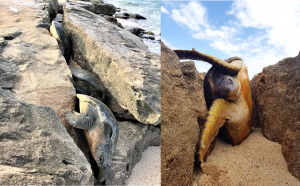
Perhaps I am anthropomorphising, but during these stranding missions, we really got an insight into their individual characters. Although maybe not the most intelligent creatures, if spatial awareness is a sign of intelligence, they were incredibly stoic. Some bore the clear signs of surviving shark attacks (tiger sharks are known to predate on them), whilst others had likely suffered from boat collisions. Yet they would continue doggedly on. Sometimes when combined with stubbornness, these character traits made them difficult to work with. If a turtle wants to push past you, away from the open ocean and towards a lacerating expanse of volcanic rock, it can take several people at once to turn it back around. Understandably they were often grumpy when we would do this, and one time one even purposefully slapped my ankles to push me out of the way! Most mornings would involve a mixture of cursing and laughter on our part, and grumbling from the turtles, yet we would try to tell them it was for their own good.
Turtle nesting tales
During the peak nesting season, around March, the beaches would look like a battleground. The entirety of the beach would be pitted with crater-like turtle holes, whilst the turtle tracks looked as if someone had repeatedly driven a tank along the length of the beach. Most mornings, we would count the fresh turtle tracks to calculate how many turtles had been on the beach the previous night, before recording the location and number of new nests. Then, in preparation for counting the next day’s tracks and nests, we would rake the whole of the beach we were surveying (to leave a ‘clean slate’). In the peak season, this could take most of the day. It was exhausting work, often carried out in temperatures approaching 40⁰C and I still never want to see a rake again! During the peak season, we recorded tracks from 419 turtles on the main nesting beach (Long Beach) after a single night, which was the second highest number ever recorded there!
Meanwhile, after incubating for around 55-65 days, the baby turtles, or hatchlings, would make their way to the surface of the beach. Emerging under the cover of darkness, they would then frantically make their way to the ocean. Being there on the beaches when this was happening remains one of the most incredible experiences of my life. As the adult females crawled slowly by, hundreds of tiny hatchlings would suddenly appear in their midst. With an ‘emergence’, first tens, and then more than one hundred tiny turtles erupt through the surface of the sand together within the space of a few minutes, before scuttling off.
As adult turtle numbers dropped off towards the end of the nesting season, more and more baby turtles could be found scurrying across the beaches. On numerous occasions I would see several emergences occur at once, with some of the hatchlings scurrying straight into me in their haste to reach the ocean. On more than one occasion, I crawled up behind a nesting adult to frantically pluck hatchlings out of harms reach, after they had plummeted into the freshly dug nest. It was pandemonium.
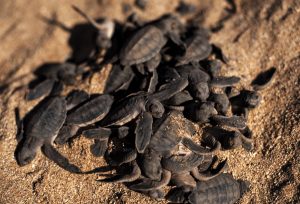
In the natural world, it is survival of the fittest. In the case of turtles, luck can also be thrown into the equation. Any hatchlings which mistakenly emerged in the sunlight would be quickly picked off by keen-eyed Ascension frigatebirds or crabs, or quickly desiccate and die in the beating sun. Even those reaching the ocean will mostly be eaten by fish higher up the food chain before reaching adulthood. It is estimated that only somewhere between 1 in 1000 and 1 in 10,000 will survive to adulthood. For those lucky enough to make it, they will return to Ascension to reproduce in another 20-25 years’ time.
Conservation efforts and what the future holds
If recovering from centuries of hunting and battling extraordinary odds to make it to adulthood were not enough, the future of this turtle population is still not guaranteed. In addition to the threat of climate change, these turtles must also contend with pollution and entanglement in fishing gear. However, in 2019, after many years in the making, Ascension Island designated its entire Exclusive Economic Zone (EEZ) as a Marine Protected Area (MPA). This puts an area of over 440,000 km2 of ocean under protection and is one of the largest MPAs in the world. This is an essential step towards offering these turtles some protection from industrial fishing fleets and lends support to ongoing conservation efforts on land.
Two years on, and the turtles have once again returned to the shores and beaches of Ascension. The streets of Bristol, where I currently live, seem a world away from the wild and extraordinary world of the turtles, yet I still think of them and miss them daily. Those nights on the beaches surrounded by turtles were some of the best of my life, and the moments spent with them will be memories that I will always treasure. It is just my hope that global and local conservation efforts will help these incredible prehistoric creatures flourish for many millennia to come.
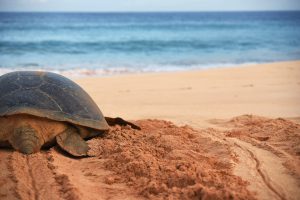
I would like to write a special thanks to BLUE for funding me and the rest of the “turtle team” and everyone at the Ascension Island Conservation Directorate. In particular, I would like to mention Jacqui Ellick (AKA the “Turtle Queen”), Matt Wall, Will Wood and James McGurk – the other members of the turtle team – whose senses of humour and hard work made even the hardest days and longest nights enjoyable.
Watch the moonlit nesting process of a Green turtle on Long Beach, Ascension Island:
Produced by Matthew Wall.
SOURCES:
Broderick A, Frauenstein R, Glen F, Hays G, Jackson A, Pelembe T, Ruxton G, Godley B (2006)Are green turtles globally endangered? Global Ecology and Biogeography, 15:21–26
Godley B, Broderick A, Hays G (2001). Nesting of green turtles (Chelonia mydas) at Ascension Island, South Atlantic. Biological Conservation, 97 (2), 151-158
Hays G, Broderick A, Godley B, Lovell P, Martin C, McConnell B, Richardson S (2002a). Biphasal long-distance migration in green turtles. Animal Behaviour, 64:895–898
Hays G, Broderick A, Glen F, Godley B (2002b). Change in body mass associated with long-term fasting in a marine reptile: the case of green turtles (Chelonia mydas) at Ascension Island. Canadian Journal of Zoology, 80:1299–1302
Hays G, Akesson S, Broderick A, Glen F, Godley B, Papi F, Luschi P (2003). Island-finding ability of marine turtles. Proceeds of the Royal Society of London, 270, S5–S7
Mortimer J, Portier K (1989). Reproductive homing and interesting behaviour of the green turtle (Chelonia mydas) at Ascension Island, South Atlantic Ocean. Copeia, 1989:962–977
Weber S, Weber N, Ellick J et al (2014). Recovery of the South Atlantic’s largest green turtle nesting population. Biodiversity Conservation, 23, 3005–3018


















